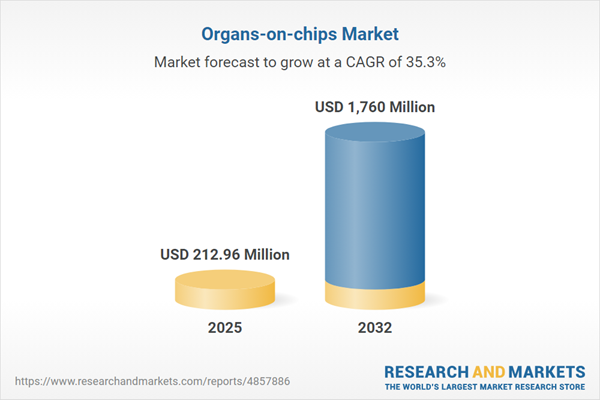Speak directly to the analyst to clarify any post sales queries you may have.
The organs-on-chips market is evolving as an enabling technology for senior R&D leaders and procurement strategists seeking to optimize life science innovation capacity and pipeline efficiency. Continued integration of advanced platforms is helping organizations manage regulatory demands while facilitating the adoption of agile operational models.
Market Snapshot: Organs-on-Chips Market Growth and Investment Landscape
In 2024, the organs-on-chips market reached USD 157.36 million, with expectations to attain USD 212.96 million by 2025 and an anticipated CAGR of 35.25% through 2032. This momentum underscores expanding interest across pharmaceutical, biotechnology, and academic sectors. Organizations are deploying next-generation chip materials and integrating lab automation and advanced analytics, ensuring their research capabilities remain both robust and agile. Advanced microphysiological systems are increasingly essential as enterprises work to differentiate in crowded markets. Ongoing regulatory developments and persistent funding opportunities are motivating sustained investor attention, supporting leaders as they refine innovation strategies and maintain operational agility amid market complexity.
Scope & Segmentation: Strategic Options in the Organs-on-Chips Market
Comprehensive segmentation in the organs-on-chips sector equips leadership teams with actionable intelligence to drive competitive positioning, support procurement, and enable geographic and operational scalability. Understanding segment-specific drivers helps ensure compliance and mitigates risk in dynamic markets.
- Material Types: Glass, PDMS, and thermoplastics deliver proven reliability and consistency for scientific workflows, supporting routine and specialty preclinical research with durable, reproducible substrates.
- Product Categories: Laboratory consumables, microplates, reagents, instruments, and workflow management software sustain routine laboratory performance and underpin high-throughput experimentation.
- Technology Formats: Single-layer and multi-layer microfluidic chips support modular design, allowing users to rapidly scale or adapt to varying organ model complexity as research needs evolve.
- End User Segments: Academic research centers, pharmaceutical and biotechnology companies, and contract research organizations are the core drivers of adoption, each leveraging platforms to accelerate translational discovery and collaboration.
- Application Areas: Disease modeling, early drug screening, personalized medicine development, and toxicity assessment define critical use cases for efficient therapeutic evaluation and safety profiling.
- Organ Types: Platforms simulate major organs, including gut, liver, lung, heart, and kidney, allowing users to refine disease pathway understanding and assess novel therapeutics more precisely.
- Geographic Regions: Growth patterns vary across North America, Europe, Asia-Pacific, Middle East, and Africa, shaped by research priorities, funding channels, and compliance requirements unique to each region.
- Competitive Landscape: Leading providers such as Emulate, Inc.; MIMETAS B.V.; TissUse GmbH; CN Bio Innovations Ltd.; InSphero AG; Nortis, Inc.; Hµrel Corporation; Tara Biosystems, Inc.; AxoSim LLC; and Kirkstall Ltd. influence both technology standards and partnership models throughout the industry.
Key Takeaways for Decision-Makers
- Advanced microfluidic technologies are enhancing experimental standardization and supporting a smoother transition of laboratory insights into practical, real-world applications.
- Use of high-grade thermoplastics is boosting experimental rigor, simplifying procurement, minimizing waste, and supporting cost-effective inventory practices.
- Automated platforms and sophisticated analytics are streamlining data management, reducing manual intervention, and improving research project oversight across geographically distributed teams.
- Collaboration among technology vendors, regulatory agencies, and research institutions is increasing transparency and enabling organizations to proactively address compliance requirements and operational risks.
- Diversification of suppliers and formalized, flexible partnerships allow organizations to address uncertainty in their supply chain, enhancing business continuity and responsiveness during global disruptions.
- Progress in international certification is promoting broader market access and building confidence across regulatory and pharmaceutical frameworks, unlocking new opportunities for stakeholders worldwide.
Tariff Impact: Navigating Cost and Supply Chain Dynamics
In anticipation of U.S. tariffs on advanced polymers and microfabrication equipment scheduled for 2025, organizations are actively diversifying suppliers and emphasizing domestic sourcing. Implementation of strong contingency planning helps mitigate risk, supporting uninterrupted operations despite a variable global trade landscape. These strategies are intended to stabilize supply continuity and control costs as market pressures shift.
Methodology & Data Sources
This report combines insights from industry leaders, regulatory bodies, and technical experts with an extensive literature review and patent analysis. Each segment is validated through multi-stage verification, ensuring objective and reliable perspectives tailored for decision-makers.
Why This Organs-on-Chips Market Report Matters
- Technology and procurement leaders can leverage timely market guidance to identify critical trends, supporting more effective portfolio management decisions.
- Clear benchmarking enables precise investment targeting by region, ensuring efficient use of resources and maximizing operational value.
- Transparent analysis of regulatory and operational complexities gives enterprises the clarity needed to adapt strategies amid changing conditions.
Conclusion
Actionable segmentation and strategic intelligence enable leaders to confidently manage regulatory and technological disruption, driving adaptable and sustainable growth within the life sciences sector.
Additional Product Information:
- Purchase of this report includes 1 year online access with quarterly updates.
- This report can be updated on request. Please contact our Customer Experience team using the Ask a Question widget on our website.
Table of Contents
3. Executive Summary
4. Market Overview
7. Cumulative Impact of Artificial Intelligence 2025
Companies Mentioned
The companies profiled in this Organs-on-chips market report include:- Emulate, Inc.
- MIMETAS B.V.
- TissUse GmbH
- CN Bio Innovations Ltd.
- InSphero AG
- Nortis, Inc.
- Hµrel Corporation
- Tara Biosystems, Inc.
- AxoSim LLC
- Kirkstall Ltd
Table Information
| Report Attribute | Details |
|---|---|
| No. of Pages | 194 |
| Published | November 2025 |
| Forecast Period | 2025 - 2032 |
| Estimated Market Value ( USD | $ 212.96 Million |
| Forecasted Market Value ( USD | $ 1760 Million |
| Compound Annual Growth Rate | 35.2% |
| Regions Covered | Global |
| No. of Companies Mentioned | 11 |









